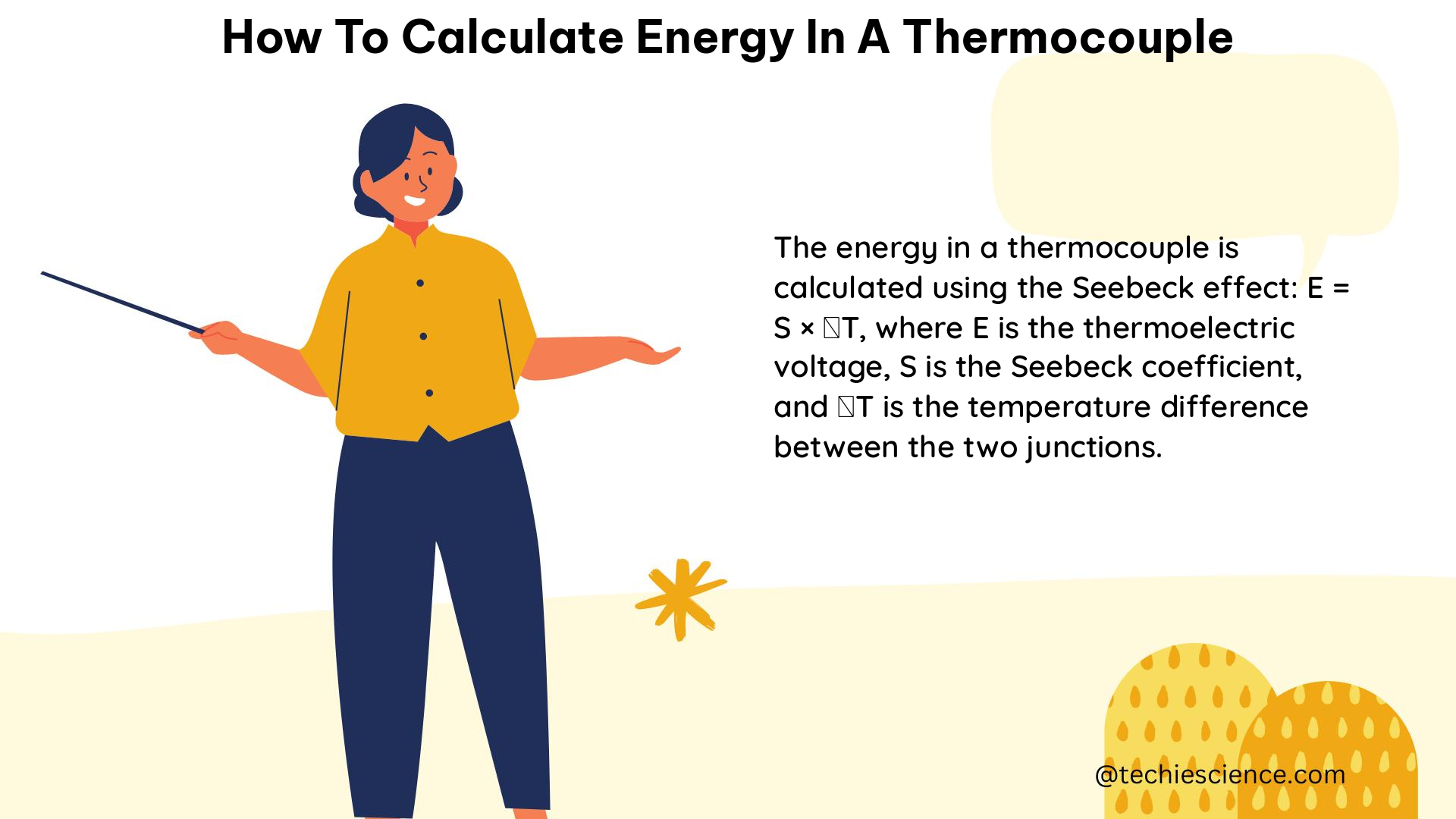Summary
Thermocouples are widely used devices that convert temperature differences into electrical energy. To calculate the energy generated by a thermocouple, you can use the formula E = αΔT, where E is the energy, α is the Seebeck coefficient, and ΔT is the temperature difference between the hot and cold junctions. This guide will provide you with a detailed understanding of the principles, formulas, and practical examples to help you accurately calculate the energy generated by a thermocouple.
Understanding the Thermocouple Principle

A thermocouple is a temperature-sensing device that consists of two dissimilar metal wires joined at one end, known as the hot junction. The other ends of the wires, called the cold junction, are connected to a voltage-measuring device, such as a voltmeter or a data acquisition system.
When the hot junction is exposed to a temperature difference compared to the cold junction, a small voltage is generated due to the Seebeck effect. The Seebeck effect is a thermoelectric phenomenon where a temperature difference between two dissimilar metals or semiconductors produces a voltage difference across them.
The voltage generated by a thermocouple is proportional to the temperature difference between the hot and cold junctions, and the Seebeck coefficient of the materials used. The Seebeck coefficient is a material-specific property that describes the voltage generated per degree of temperature difference.
Calculating the Energy Generated by a Thermocouple
To calculate the energy generated by a thermocouple, you can use the following formula:
E = αΔT
Where:
– E is the energy generated by the thermocouple (in Joules)
– α is the Seebeck coefficient of the thermocouple materials (in Volts per degree Celsius or Volts per Kelvin)
– ΔT is the temperature difference between the hot and cold junctions (in degrees Celsius or Kelvin)
The Seebeck coefficient (α) is a material-specific property that can be found in reference tables or data sheets for different thermocouple types. For example, the Seebeck coefficient for a copper-constantan (type T) thermocouple is approximately 41 microvolts per degree Celsius (μV/°C).
Example Calculation
Let’s consider a thermocouple with a temperature gradient of 2000 degrees Celsius over an area of 2 inches wide by 0.5 meters long. Assume the hot junction is at 2000°C and the cold junction is at room temperature (20°C).
-
Calculate the temperature difference (ΔT):
ΔT = 2000°C – 20°C = 1980°C -
Calculate the voltage generated using the Seebeck coefficient:
Voltage (V) = α × ΔT
Voltage (V) = 41 μV/°C × 1980°C = 80.78 mV -
Calculate the current flowing through the thermocouple using Ohm’s law:
Current (I) = Voltage (V) / Resistance (R)
Assume the resistance of the thermocouple is 1 ohm, then:
Current (I) = 80.78 mV / 1 ohm = 0.08 A -
Calculate the energy generated by the thermocouple:
Energy (E) = Current^2 × Resistance × Time
Assuming a time period of 1 second:
Energy (E) = (0.08 A)^2 × 1 ohm × 1 s = 0.00064 J
Therefore, the energy generated by the thermocouple with the given temperature gradient and dimensions is approximately 0.00064 Joules.
Considerations for Plasma-based Thermocouples
While it is theoretically possible to use a non-metal plasma as the secondary conductor in a thermocouple, this approach presents several practical challenges. The plasma would need to have a well-defined and stable temperature, and it would need to be in direct contact with the thermocouple material.
In practice, maintaining a stable plasma with a well-defined temperature and ensuring proper contact with the thermocouple material is extremely difficult. As a result, most thermocouples use a second metal as the secondary conductor, as this provides a more reliable and stable configuration.
Conclusion
Calculating the energy generated by a thermocouple is a crucial step in understanding and utilizing these devices effectively. By applying the formula E = αΔT, along with the Seebeck coefficient and temperature difference, you can accurately determine the energy output of a thermocouple. The example calculation provided in this guide demonstrates the practical application of this principle.
While the use of plasma as a secondary conductor in thermocouples is theoretically possible, the technical challenges involved make it a less practical approach compared to the traditional metal-based thermocouple design. By understanding the fundamental principles and calculation methods, you can confidently work with thermocouples and optimize their performance in various applications.
References
- A Basic Guide to Thermocouple Measurements (Rev. A), Texas Instruments, September 2018, Revised March 2023.
- Measure the Seebeck Effect with a Thermocouple Thermometer, Science Buddies, accessed on June 20, 2024.
- Energy balance in JET, ScienceDirect, accessed on June 20, 2024.
- Idealized lumped energy balance about thermocouple bead, ResearchGate, accessed on June 20, 2024.
- How would you calculate the energy generated by a thermocouple?, Physics Forums, accessed on June 20, 2024.

The lambdageeks.com Core SME Team is a group of experienced subject matter experts from diverse scientific and technical fields including Physics, Chemistry, Technology,Electronics & Electrical Engineering, Automotive, Mechanical Engineering. Our team collaborates to create high-quality, well-researched articles on a wide range of science and technology topics for the lambdageeks.com website.
All Our Senior SME are having more than 7 Years of experience in the respective fields . They are either Working Industry Professionals or assocaited With different Universities. Refer Our Authors Page to get to know About our Core SMEs.